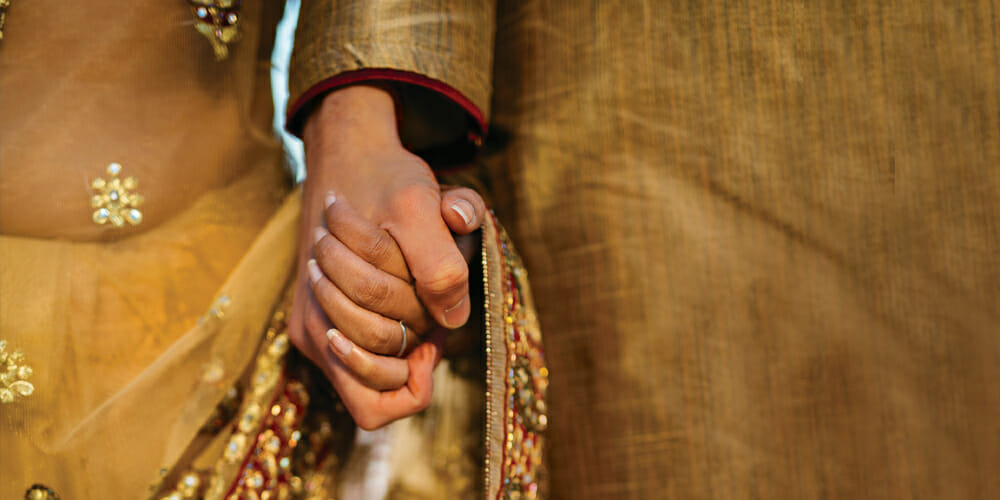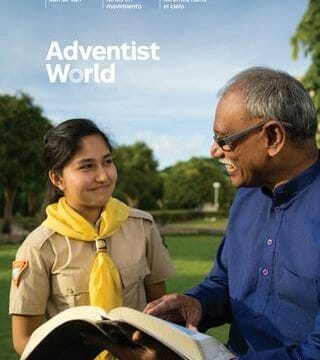God, a romantic? Well, yes. From the Garden of Eden we have two great institutions designed to keep us close to our Creator […]

God, a romantic? Well, yes.
From the Garden of Eden we have two great institutions designed to keep us close to our Creator and close to each other: Sabbath and marriage.
The Sabbath is a once-a-week reminder that God provides for our material, physical, emotional, and spiritual needs. The same can be said for marriage. Our first parents weren’t truly complete until God performed that first marriage in Eden.
And ever since, whenever a man and woman stand before a pastor or civil magistrate and promise to love, honor, and cherish, they are pledging to protect each other and bring out the best in each other. Done well, marriage partners—more than anyone else—provide for each other’s material, physical, emotional, and spiritual needs.
Sadly, we live in an imperfect world, with lots of distractions that prevent us from being ideal marriage partners. Still, God’s Word is just as valid today as when it was spoken in Eden: “It is not good that [man and woman] should be alone” (Gen. 2:18).—Editors.
Marriage in China
With the rapidly growing economy and sharp rise of materialism in China over the past 40 years, drastic changes are taking place in all aspects of people’s lives, including marriage. The traditional definition of an ideal Chinese marriage is “an intelligent man marrying a beautiful woman” (lang cai nu mao). But in China today the three most desirable qualities for an ideal husband are tall (gao), rich (fu), and handsome (shuai). For a wife, it’s fair-skinned (bai), rich (fu), and beautiful (mei).
The process of seeking marriage partners has undergone significant changes. Thanks to a relatively liberal and open society, the widespread use of social media, and the inspiration of the market economy, a huge market is now open to all seeking suitable marriage partners in China. But one Chinese marriage tradition remains strong: the influence of parents. Marriages are still the union of two families, rather than two individuals. Blind dates arranged by parents, called “xiangqin,” are still a common practice. Parents may also have a veto power in the selection of their future son or daughter-in-law.
Marriage festivities vary depending on the cultural background and financial capacity of the families. They typically start with the groom going over to the bride’s family to pay respect and appreciation to her parents and other elderly relatives, with the bride reciprocating to the groom’s family. Serving tea and receiving red envelopes with cash in them is a common practice. The celebration always ends with a wedding banquet ranging from a few dozen to thousands of guests.
Officially China is still an atheist country, but interestingly enough, church weddings have become quite fashionable. The couple and their families may not have any Christian background, but they choose church weddings for a solemn atmosphere, beautiful music, and decorations. For many churches, providing wedding services has become a significant and profitable ministry.
Eugene Hsu, originally from China, is retired after serving as a general vice president of the General Conference.
Marriage in India
In India the differences between Hindu, Muslim, and Christian wedding celebrations, as well as the differences between regions of the country, mean that no one description can suffice. This description is based on some practices from a South Indian Christian background.
Wedding activities start many days prior to the main ceremony. Both the bride and groom separately go through a number of special “baths,” whereby special perfumes, along with saffron and turmeric powder, are applied to their bodies by some elder women within their communities. These are meant to beautify the groom and bride in preparation for the big day.
The ceremony itself is usually a grand affair, with all the extended relatives on both sides of the family invited. Women wear their finest saris. Men dress in their best shirt and pants; some wear more traditional clothing as well. The bride wears a sari bought especially for the event.
One of the most important moments in the ceremony is the tying of a special thread by the groom around the bride’s neck as a symbol of love and assurance known as thali. There is also an exchange of flower garlands. The bride and groom place these over the head of each other as a sign that the union is complete.
The meal following the wedding ceremony is also a grand affair. The food is typically served on banana leaves with a wide variety of rice and curries, along with special sweets. All who attend the wedding are expected to take part in the reception and meal. Indian weddings are typically full of color and joy. The marriage event is considered by many one of the most important moments in life for both families involved.
Andrew Tompkins, a doctoral student who works for the Office of World Mission, found his life companion, Anu, while living and working in India.
Marriage in Latin America
Latin Americans (Hispanics) come from diverse social, economic, and geographic backgrounds, making them all different depending on their family heritage, national origin, and where they live. But when it comes to marriage, some cultural elements are common.
Family-orientation: Latinos are historically family-oriented. The needs of the family are more important than the concerns of individuals. Each family member is willing to sacrifice for the betterment of the others. While changing gender roles have affected Latinos, there’s still an emphasis on traditional values.
Celebration of the male: “machismo” is alive. Men should be strong, brave, and honorable; they should protect and provide for their families—all of which is positive. But machismo presents a problem by placing men over women, giving them rights and privileges denied to women—such as independence, authority, and the right to express opinions and influence decisions. Yet better educated individuals believe in more equitable decision-making.
Role delineation: in traditional families husbands are the undisputed heads of the family, responsible for their financial and physical well-being. Wives are responsible for nurturing the family and for maintaining the household. Even though most women also work, wives are seen as primary caregivers not only for their husband and children but also for parents and older relatives.
Romance: couples for the most part marry for love. Yet when children arrive, parents tend to give priority to their love for their children. Romance is highly valued, but love is often seen as unattainable and tragic, reflected in the themes of telenovelas (Hispanic soap operas).
Latin-American Adventist marriages strive to follow God’s ideals for marriage and to share the altruistic love that makes the home “a piece of heaven on earth.”
Ada Gonzalez is a marriage and family therapist originally from Cuba. She has lived in Spain, Costa Rica, and Mexico. She now lives in the United States with her husband, Roger Swain.
Marriage in North America: In Love with Love
In North America we love love. Our songs and music videos are saturated with it. In libraries and bookstores shelves groan under the weight of countless romance novels and books about how to get the most out of romantic relationships. Broadcast television and live-streamed programming at various times extol and denigrate the concept of faithfulness in marriage.
Thanks to tabloid magazines and television programs, we fixate on the extravagant weddings of singers and entertainers. Entire magazines and books are dedicated to having the perfect wedding in the perfect location, with the perfect food, clothing, and accessories.
Our fixation on the perfect wedding, however, doesn’t prevent the United States, for example, from being among the top five nations in the world with the highest divorce rates (the other four are Belarus, Aruba, Russia, Maldives). It’s not unusual to hear stories of couples getting divorced before they have a chance to pay off the exorbitant costs of their weddings.
That said, Canada and the United States are among the top five countries in the world where people stay married the longest (the other three are Italy, France, and Australia). Indeed, it’s not unusual to hear of couples staying married 60, 70, 80 years. In my own family of 13 sets of uncles and aunts, there was only one divorce. Everyone else stayed married until one spouse died, often after 50, 60, or 70 years or marriage.
In our heart of hearts, North Americans understand that strong, long-lasting marriages contribute to a strong, moral society. We understand that the goal of romance is not just to be pronounced “husband and wife.” Romance, in its purest form, provides “a little heaven here to go to heaven in.”
Stephen Chavez and his wife, Linda, have been writing their own romance novel for 46 years. They live in Silver Spring, Maryland, United States.
Marriage in Southern Africa
Marriage preparation is an intrinsic part of the wedding, whether it be traditional, or at a church, or by the registrar. Everyone plays a vital part, especially the respected elders in society. In Malawi notice must be given to the registrar and church in person one month before the wedding. Our wedding in June 2016 included both entities, and followed detailed marriage counseling.
Family, friends, and most invited attendees acquire new outfits, bought or borrowed, according to agreed color schemes. Committees meet and plan every detail of the day, with bride and groom required to give final input. The families have already met at the time of engagement, and there is a sending off similar to a bridal shower, except that the sending off also features advice on how to succeed and avoid the pitfalls of marriage.
The wedding rehearsal involves all those who are in the bridal party, including parents, minister, and those responsible for the lighting of the candles at church. The wedding march into the church is traditional.
Weddings in Malawi are all-day affairs. The bride and groom prepare and dress in host houses. Our preparations began at 4:00 a.m. for a 9:00 a.m. start with the hairdresser and even featured expensive breakfast attire fit for a king and queen. The wedding registration gives worldwide validity, with the use of the government seal on the marriage certificate. Lunch is provided in various homes: those of the bride’s and groom’s parents, and those of other friends.
The reception is a time for celebration with everyone from the community, including friends, well-wishers, and those who are just curious. No one is left out, with perikyani (throwing of money), and other festivities. It is a happy day that leaves a lifetime of memories, and is followed by a long honeymoon. Families become one indeed in much more than a formal sense: the groom’s mother is now the bride’s mother, and vice versa; the same with siblings and extended family.
The wedding day leaves fond memories.
Faith and Joseph Ngondo were married in 2016 in the southern African nation of Malawi.
Marriage Traditions in West Africa
In the animistic tribes of northern Benin, West Africa, several types of marriages exist. One is the arranged marriage. The family picks a girl for their son, often at a very young age. Both children grow up knowing that they are chosen for each other. Once the boy reaches teenage years, he starts working for his father-in-law to pay the dowry. At the age of 18 to 20 both take part in the initiation ceremonies, after which they are ready to get married.
One night after the initiation ceremonies the young man goes to his in-laws’ home to kidnap his girl. The parents are sleeping (at least they pretend to be sleeping). The young woman doesn’t join him in his hut, however; instead, she sleeps with his mother until the actual wedding day. A few days later the young man goes back to his in-laws’ home to tell them that their daughter is with him. Then wedding preparations start.
Throughout all those years the parties involved have the right to step back from the arrangement. Even after the boy has taken the girl to his house, she or her parents can still oppose the union. The wedding is a big party with lots of food, music, and dancing. Interestingly, there is no spiritual aspect to the wedding. Both the young man and woman were dedicated to the fetish—or the “spirit of the ancestor” they believe is reigning in the life of their clan. Neither God nor the “spirits of the ancestors” are invoked at the wedding.
Adventist or other Christian weddings may also adopt some Western-style traditions.
Ulrike Kouato-Baur lives in Benin, West Africa, serving with Adventist Frontier Missions together with her husband, Toussaint.








